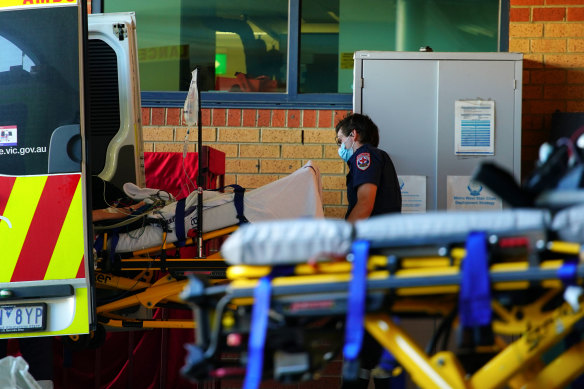Save articles for later
Add articles to your saved list and come back to them any time.
It’s a scenario where every minute counts. But suspected stroke and heart attack victims are spending more than an hour on ambulance trolleys waiting for time-critical diagnosis and treatment because Victorian emergency departments are too overcrowded to admit them.
The extent of the state’s ambulance ramping crisis has been laid bare by new data obtained by this masthead showing that the equivalent of 65,457 eight-hour ambulance shifts have been lost to the phenomenon in the past five years alone.
Nicky Pattison faced a long wait at Monash Medical Centre this year after suffering a heart attack.Credit: Wayne Taylor
Ambulance crews currently face average hospital transfer times of one hour and twenty minutes, well above the target of 40 minutes, according to Ambulance Victoria.
Earlier this year, Melbourne woman Nicky Pattison spent about three hours on an ambulance trolley in a corridor of Monash Medical Centre after she had a heart attack.
She arrived at the hospital after waking at 3am on February 6 with chest pains. Her husband frantically called triple zero for help and Pattison, a social worker who had previously been diagnosed with heart disease, was anxious.
“I was worried I wouldn’t survive,” she recalled.
There were no cardiologists available at the major hospital in Melbourne’s south-east, so Pattison was eventually transferred via ambulance to St Vincent’s Hospital in East Melbourne, where she spent the next five days receiving treatment.
A Monash Health spokesman confirmed that on the day of Pattison’s heart attack, the Clayton hospital’s emergency department experienced a higher-than-average demand, more acute presentations and ambulance arrivals.
“We want to assure the community that all patients are supported and monitored as they wait,” the spokesman said.
There will be no quick fix for the growing problem of ambulance ramping.
On Monday, Victorian Health Minister Mary-Anne Thomas called on the federal government to “step up and play its role” in addressing the drivers of the problem, while federal Health Minister Mark Butler said his government was already embarking on a series of reforms “after nine long years of cuts and neglect by the former government”.
Heart Foundation chief medical adviser Professor Garry Jennings said every minute counted when it came to treating a heart attack or stroke.
“For heart attack, every minute treatment is delayed means more heart muscle is lost,” he said. “For stroke, more brain cells are lost.”
Jennings said an hour delay could be the difference between someone having a normal quality of life or a long-term disability.
“Ramping is time wasted both for the health professionals and for those people who need urgent procedures,” he said.
“It is of particular concern if ramping comes to be seen as a normal part of health care.”
He said guidelines recommend that electrocardiogram monitoring, which now takes place in many ambulances, should begin within 10 minutes of first being seen.
Blood tests and a presumptive diagnosis should commence within an hour followed by immediate treatment, if necessary, to remove blocked arteries with medications or a procedure.
A patient arrives at the Northern Hospital in Melbourne, where the ambulance waiting bay is often busy or full.Credit: Luis Enrique
Research released last year by Ambulance Victoria, Monash University, the Royal Melbourne Hospital, Alfred Health and the Baker Heart Research Institute showed that patients with chest pain faced a higher risk of dying within 30 days if it took longer than 17 minutes for an ambulance to offload them to a hospital.
However, several paramedics recalled instances where patients showing signs of a heart attack or stroke waited at least an hour to be admitted.
Two young paramedics at Sunshine Hospital last week said they had just waited about 90 minutes to offload a category-one patient who they suspected might have had a stroke.
The pair, who are not authorised to speak publicly, said that instead of being sent straight for a CT scan, their “agitated patient” was assessed by the hospital’s stroke team on a stretcher in front of about 10 other patients also waiting for a bed.
A veteran emergency department doctor, Professor Peter Cameron, said while most ambulance patients with clear and serious problems were quickly admitted to hospital, it was not always the case for people with less-obvious ailments that required a doctor to examine them and take a detailed history.
“That part of it is virtually impossible to do in a corridor,” said Cameron, a senior member of Monash University’s School of Public Health and Preventive Medicine.
“So you will miss subtle presentations of heart attacks, strokes, sepsis, and things that kill people, or maim people by delayed diagnosis.”
Cameron joined the calls for a redesign of how people access medical care in Australia, so patients no longer had to go to emergency departments with chronic and other illnesses that would be better managed by a GP or other specialists.
“The problem we’re dealing with now is that the emergency department is basically the only funnel through which sick people can get care, especially after hours, which is about three-quarters of the week.”
Thomas said resolving hospital “bed block” – a key driver of ambulance ramping – depended on reforms in areas overseen by the federal government, not the Victorian government.
“At any given time in our hospital systems, we’ll have more than 300 people (that’s almost a whole hospital) who are medically well and fit to be discharged, but … there is nowhere suitable for them to be discharged to,” the Victorian health minister said.
“This is as a consequence of [National Disability Insurance Scheme] packages not being … developed and approved within time. This is a consequence of people in our community losing confidence in the private aged care system.”
Butler, meanwhile, outlined the work the Albanese government had done to address growing problems with GP access and affordability, issues also worsening emergency department overcrowding.
“Our historic investments in Medicare will triple the bulk billing incentive – the largest increase to the incentive in the 40-year history of Medicare,” Butler said.
State opposition health spokeswoman Georgie Crozier said Victoria’s ambulance ramping crisis exposed the Andrews government’s mismanagement and would worsen because of the state government’s decision to impose a payroll tax on GPs.
As Pattison was leaving the Monash Medical Centre in February, said she saw at least six other ambulances ramped out the front.
She said she cannot fault the care for her heart attack she received from paramedics, nurses and doctors, but said they were constrained by a shortage of beds.
“Paramedics are standing in corridors in hospital, twiddling their thumbs when they could be out,” she said. “People have died as a result of ambulance delays, thank God I wasn’t one of them. Those poor families and those poor paramedics deserve better.”
New data has exposed the severity of Victoria’s ambulance crisis as hospital ramping costs paramedics 120 years of shifts. Read the full story here.
The Morning Edition newsletter is our guide to the day’s most important and interesting stories, analysis and insights. Sign up here.
Most Viewed in Politics
From our partners
Source: Read Full Article

